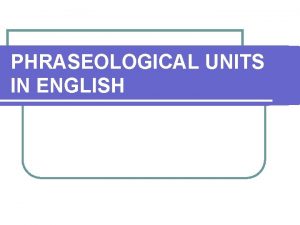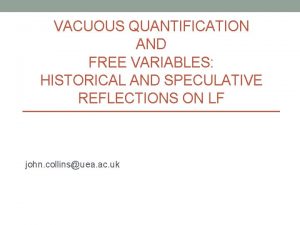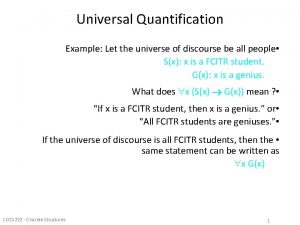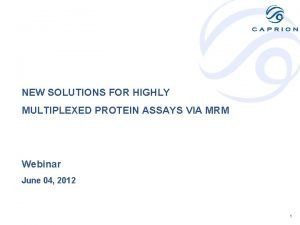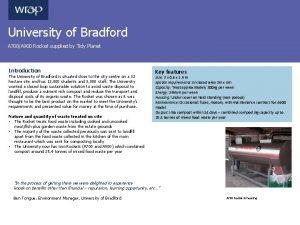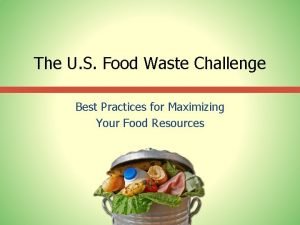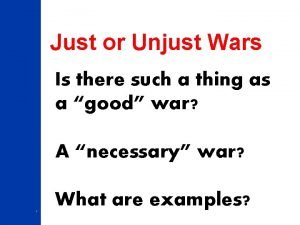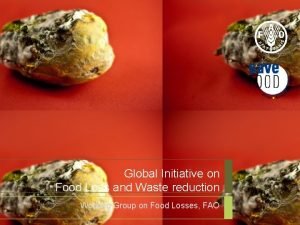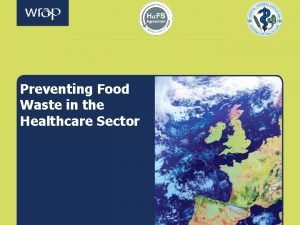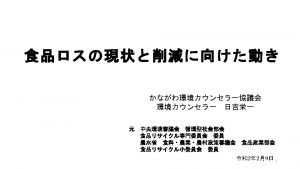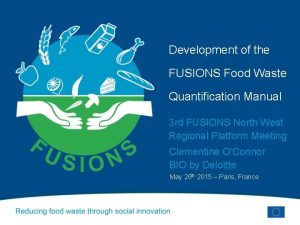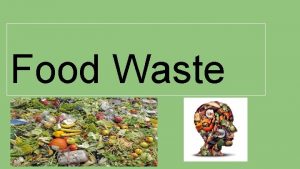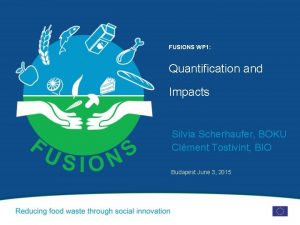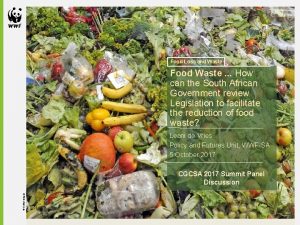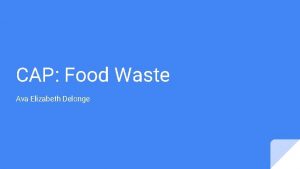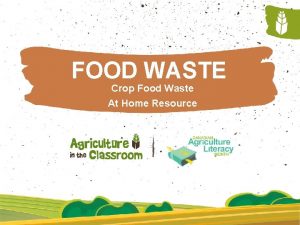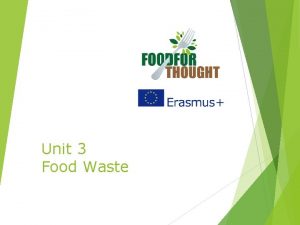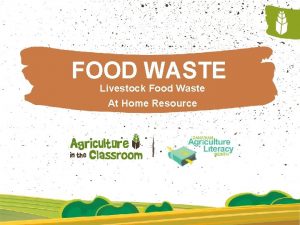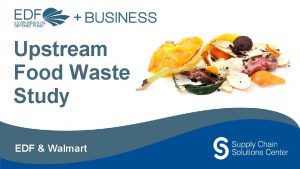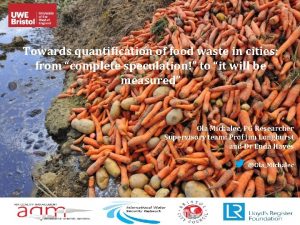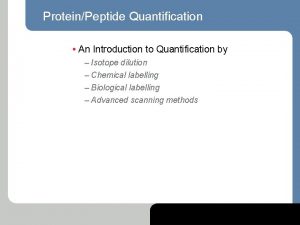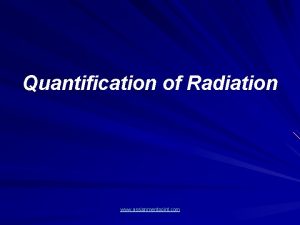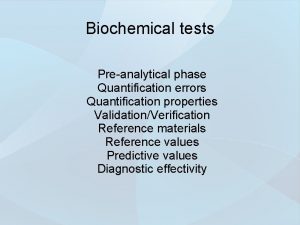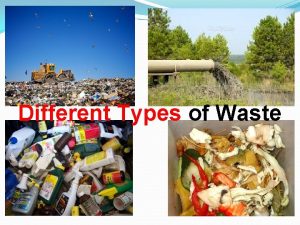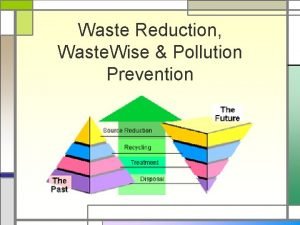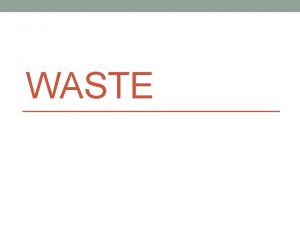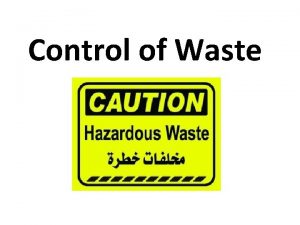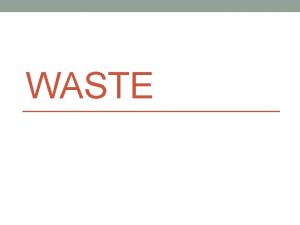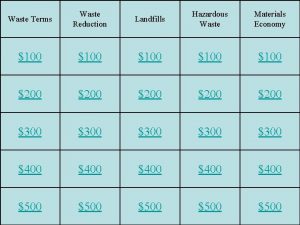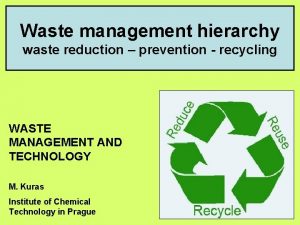Development of the FUSIONS Food Waste Quantification Manual


























- Slides: 26

Development of the FUSIONS Food Waste Quantification Manual 3 rd FUSIONS Central Europe Regional Platform Meeting Clement Tostivint BIO by Deloitte June 3 rd 2015 – Budapest, Hungary

Purpose of the Manual “The Food Waste Quantification manual will give practical guidelines on how to measure and quantify food waste in different steps of the food chain. This manual will provide guidelines for a standard approach for EU 28 on how to continuously measure and quantify food waste in different steps of the food supply chain. ” – From the FUSIONS Description of Work Framework for Quantification at National Level Quantification by Sector It will provide recommendations on reporting to the European Commission, that can be used in relation to a prevention target.

Purpose of the Manual Target audience: Member State authorities responsible for quantifying food waste or reporting their country’s progress towards a possible EU target. In practice, likely to be the government agency already responsible for waste statistics (e. g. Environment Ministries or Agencies). It aims to support these authorities in developing a coherent national approach to food waste measurement. It can also be used as a reference by: • Researchers collecting data on behalf of national authorities • National statistical offices

Purpose of the Manual The Manual supports Member States in: • Quantifying food waste in each sector (i. e. step) of the food chain; • Combining sectoral quantifications using a common framework at national level; and • Reporting the results of the national food waste quantification study at country level and potentially to the European Commission.

Overview of the Manual Chapter 1: Purpose of the Manual Chapter 2: Terminology Chapter 3: Definition of food waste in this document Chapter 4: Recommended approach for national food waste quantification study Chapter 5: Recommended approach for Primary Production Chapter 6: Recommended approach for Processing & Manufacturing Chapter 7: Recommended approach for Wholesale, Retail and Markets Chapter 8: Recommended approach for Food services Chapter 9: Recommended approach for Other sectors Chapter 9: Recommended approach for Households

Chapter on Terminology • This chapter presents all key terms • Terms are in line with the FLW Standard except when there is FUSIONS specific terminology: e. g. Food, Food supply chain, Food and inedible parts of food, Valorisation and conversion, Food Waste New terms have been introduced: • National Food Waste Quantification Study (NFWQS) : “The process undertaken to quantify food waste at national level as presented in the Manual” • National Food Waste Quantification Report (NFWR) : “A report that describes in a transparent way results of a NFWQS as well as other items required to be reported in conformance with the Manual”.

Chapter on recommended approach for National Food Waste Quantification Study (NFWQS) Key principles • This chapter includes all general recommendations – i. e. non sector-specific recommendations • It is harmonized with the FLW Standard – FLW Standard’s requirements and recommendations are adapted/refined to match with the context and objectives of the Manual – The manual fits well in the broader framework developed by the Protocol. – For the sake of consistency, it is crucial to adopt the same general approach to avoid confusion for users of both documents – When developing methodologies, it is common practice to build on existing standards to further refine them, • The Manual makes a distinction between “core requirements” and “optional recommendations” (see next slide)

Chapter on recommended approach for NFWQS Contents of this chapter Why prepare a NFWQS • 1 primary objective Core requirements • Various secondary objectives Optional recommendations Scope of the NFWQS Similar step by step approach for each sector Combination of sectoral food waste quantifications in the NFWQS Reporting

Key aspects of NFWQS Requirements and recommendations More data collection effort, more resources needed for MS Optional recommendations for MS internal use of the NFWQS Core requirements to allow MS evaluate food waste in a similar manner 1 objective • In order to be able to gather national level data in a pragmatic and comparable way (in case of limited resources) • Increase granularity of data collection > More opportunity for data analysis and policy action • Reduce uncertainty of NFWQ • Increase profitability in a sector, identify causes of waste, etc. Various secondary objectives

Key aspects of NFWQS Scope Timeframe Boundaries Scope of a NFWQS Destination Material Type

Key aspects of NFWQS Scope Timeframe • Core requirement = period of one year Material type • Core requirement = quantify the amount of both food and associated inedible parts. The amount reported is thus a combination of both. • Optional recommendation = quantify the amount of food and inedible parts separately, and then report the results combined along with separate results for each type (increased granularity)

Key aspects of NFWQS Scope Destination • According to the FUSIONS definition, any food or inedible parts of food sent to animal feed, bio-material processing or other industrial uses are termed ‘valorisation and conversion’ and thus are not considered ‘food waste’. • Core requirement: quantify the “food waste” amount: – “Food waste” category – i. e. food or inedible parts of food sent to other destinations than those of “Valorisation and conversion” category And distinguish it from “Valorisation and conversion” : – “Valorisation and conversion” category – i. e. food or inedible parts of food sent to animal feed, bio-material processing or other industrial uses. This shall not be accounted for in the food waste amount. It shall be distinghished from food waste but it is not a requirement to quantify it. • Optional recommendation: quantify separately all possible destinations as defined by FUSIONS (a dozen destinations, see next slide)

Key aspects of NFWQS Scope Destinations

Key aspects of NFWQS Scope Boundaries • Core requirement = report the boundaries of the NFWQS considering food category, lifecycle stage and geography Boundary dimension Definition Explanation Food category The food and/or its associated inedible parts leaving the food supply chain that are being quantified. All type of food and associated inedible parts shall be included in the NFWQS. If certain food categories are not accounted for, the user of the Manual shall specify which ones using the Global Product Category (GPC) codes. (version as of June 2014). Sector or Lifecycle The stages in the food supply chain within which food All sectors listed in this Manual shall be included in the NFWQS. stage waste occurs. If certain sectors are not accounted for, the user of the Manual This Manual uses a sectoral approach to cover the shall specify which ones using the NACE codes. entire food supply chain: primary production, manufacturing, retail & distribution, food service and households. Geography Geographic borders within which food waste occurs. The entire country shall be considered in the NFWQS. If certain areas are not accounted for, the user of the Manual shall specify which ones using the EU Nomenclature of Territorial Units for Statistics (NUTS) and if needed, Local Administrative Units (LAU) levels.

Key aspects of NFWQS Similar step by step approach for each sector Decide how to quantify food waste Steps of the general approach for sectoral quantifications of food waste

Key aspects of NFWQS Similar step by step approach for each sector Decide how to quantify food waste Key principles: • Understanding the definition of the sector (i. e. what is included in it or not) as well as what constitutes food waste in this sector (in coherence with the FUSIONS definition). • Mapping of the sector – The user of the Manual should carry out an initial study in order to have a general understanding of the sector’s value chain. • This can help greatly with subsequent activities for instance: – Identifying existing estimates and raw data; – Ensuring, where sampling takes place, that the sample is representative of the situation within the Member State. • Using existing data – the philosophy of the Manual is to always try to make the most of already existing data/records (see next slide)

Key aspects of NFWQS Similar step by step approach for each sector Decision tree for approaches to quantification in NFWQS

Key aspects of NFWQS Coordinating and combining sectoral food waste quantifications to perform NFWQS Key principle • This section provides guidance to the user of the Manual on how to consolidate results from the sectoral quantifications into one National Food Waste Quantification Study • The organisation in charge of the consolidation of sectoral quantifications is referred to as the “coordinating organisation”. • Core requirements in this section are not very strict and are formulated in general terms

Key aspects of NFWQS Reporting Key principle • For a MS, reporting NFWQS results may have two main objectives: – A first objective may be to publicly disclose the national food waste quantities in the context of developing a coherent national approach to food waste issues – i. e. voluntary national reporting aiming to build knowledge and prioritise areas for action. – Another objective may be to communicate the waste quantities (expressed in weight) to the European Union in the future – i. e. EU reporting • The Manual provides optional recommendations in relation to the voluntary national reporting If EU reporting is foreseen: • The Manual could provide a core requirement that the coordinating entity report to the European Commission using a predefined template including sections to report figures and sections to qualitatively explain the methodology used for each sector, the uncertainty, reporting restrictions encountered, etc.

Illustrative sector specific guidance: Retail Sector 1 – Review the scope of the sector : • Definition of wholesale, retail and markets Retail, wholesale and markets: 3 distinct sub-sectors. For each of them: – Basic definition + more (illustrative) details on what is included + NACE code (if any) – Boundaries in terms of life cycle stages included (other aspects already addressed in chapter 6): starting point, end point are core requirements • Mapping of wholesale, retail and market “sectors” Gather information on the structure of the sector = core requirement The Manual will provide a few examples on what to consider in the case of retail but we leave it quite open to the MS on what to do. 2 – Set up a work plan 3 – Identify and review existing food waste data and records = core requirement For the moment we provide a few examples on the type actors that may have records (adapted from previous FUSIONS deliverable D 1. 4) 4 – Select approach for data collection (i. e. use existing data / start new study)

Retail Sector Launch a new study – Recommended quantification methods Key Principle : Recommended methods are adapted from FUSIONS Deliverable D 1. 4 It is a core requirement to use these methods if a new data collection process is initiated. Specialist wholesale markets: Same as “markets”. Only one possible approach: Registration of the waste from the waste management company and conduct waste sorting analyses to determine composition and calculate amounts. For markets, the approach should not be conducted for each individual market retailer but by the responsible market authority who also has access to the necessary waste management data. Cash and carry wholesalers: Same as “Modern grocery retail”. Recommended approach: collection at store level of food waste data deriving from stock-keeping/book keeping tools Retailers Modern grocery retail: Recommended approach: collection at store level of food waste data deriving from stock-keeping/book keeping tools Independent and traditional shops: Only one possible approach: Registration of the waste from the retailer´s waste management company and conduct waste sorting analyses to determine composition and calculate amounts. Markets Only one possible approach: Registration of the waste from the waste management company and conduct waste sorting analyses to determine composition and calculate amounts.

Questions for the Public Sector • Are there specific food waste objectives in your country? Does the Manual approach meet your measurement needs regarding national objectives or are other elements needed? • Do you intend to quantify food waste at each possible destination (landfill, anaerobic digestion, composting etc. ) or a total figure only? • What possible sources of funding could be used to cover food waste data collection? • Do you think MS reporting on food waste to the European Commission is helpful? • Any other feedback on the Manual approach?

Questions for the Private Sector Businesses in the food supply chain have a key role to play in developing sectorlevel food waste data. • What is the best way to engage food sector business? Are incentives needed to share data? • What role is your business happy to play in food waste data collection? • In determining data samples, can participation be required or should companies volunteer their data? • What confidentiality issues around food waste data must we be aware of? • Would entities feel more comfortable to launch a dedicated food waste measurement project using a methods based on direct measurements rather than using existing data from internal softwares (ERPs) ? •

Questions for Researchers • What is your general feedback on the practicality of the approach the Manual proposes? • Do you see any technical barriers to quantifying food waste at each possible destination (landfill, anaerobic digestion, composting etc. ), rather than just a consolidated national food waste figure? • Do you see any specific issues determining “food intended for human consumption” (edible food)? • Do you have any recommendations for engaging the private sector in order to access data? • Based on your experience collecting waste data, can you estimate the cost of a national food waste quantification study?

Contacts Thank you for your attention! Please contact Clementine O’Connor or Clément Tostivint for further information about the Manual or to provide more detailed comments: cloconnor@bio. deloitte. fr www. eu-fusions. org @cxoconnor ctostivint@bio. deloitte. fr

 Phraseological collocations
Phraseological collocations Vacuous quantification
Vacuous quantification Universal quantification examples
Universal quantification examples Highly multiplexed protein quantification
Highly multiplexed protein quantification Unit 2 food food food
Unit 2 food food food Eltonian pyramid
Eltonian pyramid Food waste bradford
Food waste bradford Der deutsche student translation
Der deutsche student translation Food waste management software
Food waste management software Wars involving us
Wars involving us Food loss and waste
Food loss and waste Food waste management system
Food waste management system Food loss and waste
Food loss and waste Food waste management system
Food waste management system Food waste usa
Food waste usa Hát kết hợp bộ gõ cơ thể
Hát kết hợp bộ gõ cơ thể Lp html
Lp html Bổ thể
Bổ thể Tỉ lệ cơ thể trẻ em
Tỉ lệ cơ thể trẻ em Voi kéo gỗ như thế nào
Voi kéo gỗ như thế nào Thang điểm glasgow
Thang điểm glasgow Hát lên người ơi
Hát lên người ơi Các môn thể thao bắt đầu bằng tiếng nhảy
Các môn thể thao bắt đầu bằng tiếng nhảy Thế nào là hệ số cao nhất
Thế nào là hệ số cao nhất Các châu lục và đại dương trên thế giới
Các châu lục và đại dương trên thế giới Công thức tính độ biến thiên đông lượng
Công thức tính độ biến thiên đông lượng Trời xanh đây là của chúng ta thể thơ
Trời xanh đây là của chúng ta thể thơ
